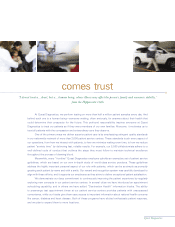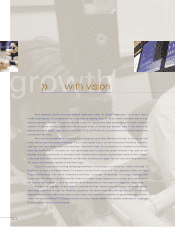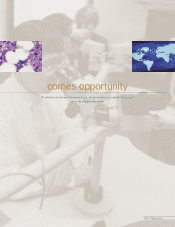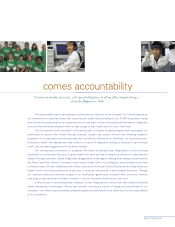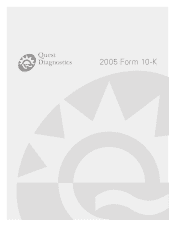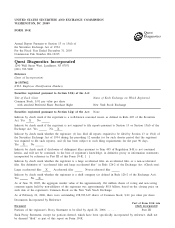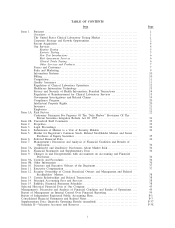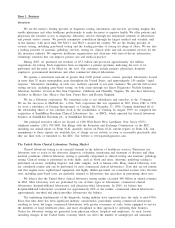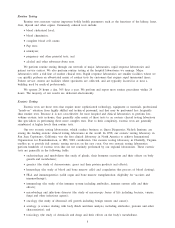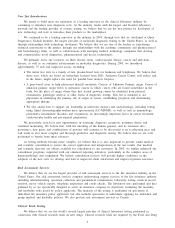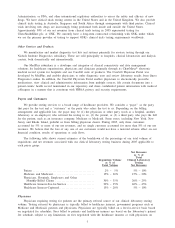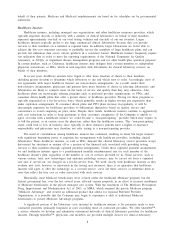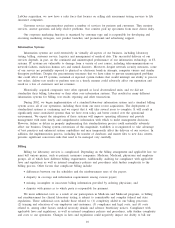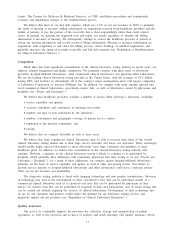Quest Diagnostics 2005 Annual Report Download - page 18
Download and view the complete annual report
Please find page 18 of the 2005 Quest Diagnostics annual report below. You can navigate through the pages in the report by either clicking on the pages listed below, or by using the keyword search tool below to find specific information within the annual report.
Item 1. Business
Overview
We are the nation’s leading provider of diagnostic testing, information and services, providing insights that
enable physicians and other healthcare professionals to make decisions to improve health. We offer patients and
physicians the broadest access to diagnostic laboratory services through our nationwide network of laboratories
and patient service centers. We provide interpretive consultation through the largest medical and scientific staff
in the industry, with more than 500 M.D.’s and Ph.D.’s around the country. We are the leading provider of
esoteric testing, including gene-based testing and the leading provider of testing for drugs of abuse. We are also
a leading provider of anatomic pathology services, testing for clinical trials and risk assessment services for the
life insurance industry. We empower healthcare organizations and clinicians with state-of-the-art information
technology solutions that can improve patient care and medical practice.
During 2005, we generated net revenues of $5.5 billion and processed approximately 144 million
requisitions for testing. Each requisition form accompanies a patient specimen, indicating the tests to be
performed and the party to be billed for the tests. Our customers include patients, physicians, hospitals,
employers, governmental institutions and other commercial clinical laboratories.
We operate a nationwide network of greater than 2,000 patient service centers, principal laboratories located
in more than 35 major metropolitan areas throughout the United States, and approximately 150 smaller “rapid
response’’ laboratories (including, in each case, facilities operated at our joint ventures). We provide full esoteric
testing services, including gene-based testing, on both coasts through our Quest Diagnostics Nichols Institute
laboratory facilities, located in San Juan Capistrano, California and Chantilly, Virginia. We also have laboratory
facilities in Mexico City, Mexico, San Juan, Puerto Rico and Heston, England.
We are a Delaware corporation. We sometimes refer to our subsidiaries and ourselves as the “Company’’.
We are the successor to MetPath Inc., a New York corporation that was organized in 1967. From 1982 to 1996,
we were a subsidiary of Corning Incorporated, or Corning. On December 31, 1996, Corning distributed all of
the outstanding shares of our common stock to the stockholders of Corning. In August 1999, we completed the
acquisition of SmithKline Beecham Clinical Laboratories, Inc., or SBCL, which operated the clinical laboratory
business of SmithKline Beecham plc, or SmithKline Beecham.
Our principal executive offices are located at 1290 Wall Street West, Lyndhurst, New Jersey 07071,
telephone number: (201) 393-5000. Our filings with the Securities and Exchange Commission, or the SEC,
including our annual report on Form 10-K, quarterly reports on Form 10-Q, current reports on Form 8-K, and
amendments to those reports, are available free of charge on our website as soon as reasonably practicable after
they are filed with, or furnished to, the SEC. Our website is www.questdiagnostics.com.
The United States Clinical Laboratory Testing Market
Clinical laboratory testing is an essential element in the delivery of healthcare services. Physicians use
laboratory tests to assist in the detection, diagnosis, evaluation, monitoring and treatment of diseases and other
medical conditions. Clinical laboratory testing is generally categorized as clinical testing and anatomic pathology
testing. Clinical testing is performed on body fluids, such as blood and urine. Anatomic pathology testing is
performed on tissues, including biopsies, and other samples, such as human cells. Many clinical laboratory tests
are considered routine and can be performed by most commercial clinical laboratories. Tests that are not routine
and that require more sophisticated equipment and highly skilled personnel are considered esoteric tests. Esoteric
tests, including gene-based tests, are generally referred to laboratories that specialize in performing those tests.
We believe that the United States clinical laboratory testing market exceeded $40 billion in annual revenues
in 2005. Most laboratory tests are performed by one of three types of laboratories: commercial clinical
laboratories; hospital-affiliated laboratories; and physician-office laboratories. In 2005, we believe that
hospital-affiliated laboratories accounted for approximately 60% of the market, commercial clinical laboratories
approximately one-third and physician-office laboratories the balance.
The underlying fundamentals of the diagnostic testing industry have improved since the early to mid-1990s.
Since that time there has been significant industry consolidation, particularly among commercial laboratories,
resulting in fewer but larger commercial laboratories with greater economies of scale, better equipped to service
the members of large healthcare plans, and more disciplined in their approach to operating their business.
Orders for laboratory testing are generated from physician offices, hospitals and employers. As such, factors
including changes in the United States economy which can affect the number of unemployed and uninsured,



